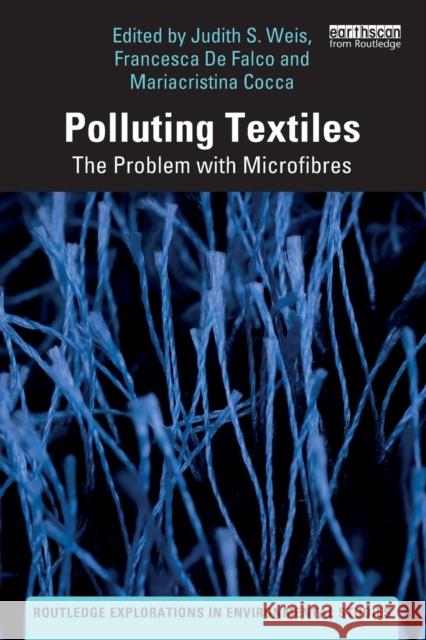Polluting Textiles: The Problem with Microfibres » książka



Polluting Textiles: The Problem with Microfibres
ISBN-13: 9780367760755 / Angielski / Miękka / 2022 / 302 str.
Polluting Textiles: The Problem with Microfibres
ISBN-13: 9780367760755 / Angielski / Miękka / 2022 / 302 str.
(netto: 176,12 VAT: 5%)
Najniższa cena z 30 dni: 183,41
ok. 22 dni roboczych
Bez gwarancji dostawy przed świętami
Darmowa dostawa!
This book examines the critical issue of environmental pollutants produced by the textiles industry.
Wydanie ilustrowane
"Our field should welcome this piece of writing with open arms. Although there are many writings about microplastics, microfibers are complex and include more than just plastic materials. I'm thrilled to see a comprehensive book, covering both science and solutions for microfibers specifically, led by a wonderful team of experts."
Chelsea M. Rochman, Department of Ecology and Evolutionary Biology, University of Toronto, Canada
"Microplastics are poorly understood but pose a serious environmental and public health risk. This book shines a light on the problem. Unlike what policy makers and society did with climate change, it is imperative that we listen to the scientists on this vital issue. This book will help do that."
Judith Enck, former EPA Regional Administrator and President of Beyond Plastics
"Microfibers - a form of microplastics - present significant challenges to scientists, policymakers, and the textile industry. This comprehensive book provides a summary of the state-of-the-science of the sources, pathways, monitoring techniques, and impacts of microfibers from leading scientists in this rapidly emerging field. Potential solutions to the hazards of microfibers and their added chemicals - from upstream measures such as policy and design innovations to downstream measures such as pollution pathway controls - are critically assessed through collaborations between textile professionals and environmental scientists alike."
Scott Coffin, Research Scientist at the California State Water Resources Control Board, developing health-based regulations for microplastics
"This book's investigation of microplastics is not only crucial for our understanding of the plastics problem for advocates and policymakers, it reveals the necessary shift textile manufacturers must make if we are to ever stop it." Stiv Wilson, CoDirector at Peak Plastic Foundation, creator The Story of Plastic film
"For a long time, textile microfibers have been simply considered as a sub-category of microplastics, thus preventing us from fully understanding the real extent of this global pollution issue. The publication of this book by an excellent team of authors provides us for the first time with all necessary tools to better comprehend this emerging pollutant, its sources, its impacts and the relevant solutions. Shifting the focus to fibres, and finally considering them as a very specific class of contaminants, represent a much-needed groundbreaking step in the right direction." Giuseppe Suaria, Research Scientist at CNR-ISMAR, Italy
"There are a number of different sustainability considerations across the entire life-cycle of textiles, including environmental pollution. This book highlights one important aspect of environmental pollution from textiles: microplastic fibers. Featuring prominent scientists in the field today, a wide array of problems and solutions are addressed in this collection which can serve as an important resource for those interested in reducing the negative environmental impacts of textiles from a number of different viewpoints." Denise Mitrano, Professor, Department of Environmental Systems Science, ETH Zürich, Switzerland
1. Introduction to textile pollution Part 1: Environmental Problems 2. Microfibre methodologies for the field and laboratory. 3. Animals and microplastics: ingestion, transport, breakdown, and trophic transfer 4. Clothes encounters of the microfibre kind: the effects of natural and synthetic textiles on organisms. 5. Toxic chemicals in textiles and the role of microplastic fibres as a source and vector for chemicals to the environment Part 2: Textile Solutions 6. Microfibre shedding from textiles during laundering: different quantification methods but common findings 7. Wastewater treatment approaches to remove microplastics: microfibres incidence and fate 8. Degradation of fibrous microplastics in the marine environment 9. Sourcing and re-sourcing end-of-use textiles 10. Innovative approaches to mitigate microfibre pollution 11. Policies and perspectives on regulating microplastic fibre pollution 12. Summary
1997-2025 DolnySlask.com Agencja Internetowa
KrainaKsiazek.PL - Księgarnia Internetowa









